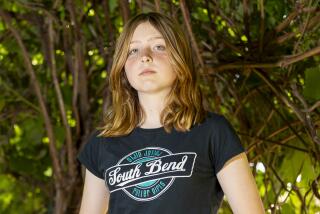Greenhouse Maps Smog Effects on Plant Life
So we laugh about Michael Jacksonâs âsleeping chamberâ filled with purified air, and called Howard Hughes a fanatic for living in a sterile environment. But the question most often asked around the smog-free greenhouse at the L.A. Arboretum is, âHow can I get one of these systems for my home?â
The inquiry is understandable after youâve looked into the greenhouse--filled with robust plants--which by no coincidence is next door to a greenhouse with normal air. The plants in the regular greenhouse are smaller; some of the leaves are brown, discolored or curling, and the plants themselves are weaklings compared to those dwelling in the smog-free environment. The startling thing is, the struggling plants in the regular greenhouse are breathing the same air we do.
The smog-free greenhouse is part of an educational project in its third year at the Los Angeles State and County Arboretum. Funded by a grant from the state Air Resources Board, officials in Sacramento are keeping close tabs on the progress of the plants, receiving photographs every month of plants from both greenhouses to see what effect smog is having.
Air Is the Variable
Though its greenhouse is mainly an educational display, not a research project, the Arboretum has been able to determine when smog is detrimental to certain plants because the only variable is the air. The young plants that are put in the greenhouses are identical, all started in the propagation area in the nursery and put into the filtered air as 2-inch plants. When the roots are established (4 inches), they are separated, six plants in the filtered air, six in regular air.
There are about 32 kinds of vegetables and bedding plants and 20 different trees and shrubs in each greenhouse. They are given the same amounts of water, fertilizer and care. With the aid of the filtering system, the smog-free greenhouse has the impurities (i.e. pollution) taken out.
A monitoring system outside the greenhouses detects the ozone and nitrogen dioxide levels of the ambient air (smog-free house). There are also photographs of healthy plants and of plants affected by the smog in a display nearby.
âSome plants do better than others (in smoggy conditions),â says June Petrie, a student of ornamental horticulture who works in the greenhouses. âLike bush beans, within the first four weeks you can see a difference. Petunias, begonias and zinnias--a lot of the bedding plants people use all the time--are greatly affected by the smog.â
Blotches on the Palm
The plants chosen for the project are often those suggested by visitors, who fill out questionnaires. âItâs not meant to tell people what plants to grow,â says John Provine, Arboretum superintendent. One request came from UC Riverside to test the Washington palm.
âThey were noticing yellow blotches on the fan palms and they werenât sure what was causing them,â recalls Provine. âThey asked if weâd try it, and sure enough, they both started out in the clean air, and the one in smoggy air developed the spots.â
The smog has, in fact, affected the areaâs economy. âThe L.A. area used to be a hotbed for spinach,â says Provine, who has worked at the Arboretum since 1958. âSpinach used to be grown on a large scale here, but you canât have spotty, blotchy spinach on the market.â
Smog also drove away flower producers, Provine says. âA lot of growers moved out--orchid growers moved to Santa Barbara and the coastal area, because the flowers were getting blemishes here, so they werenât salable.â
Tracking the Damage
Though the project has proven that smog is often the culprit when thereâs a problem with a plant, smog damage isnât always easy to detect.
âIf you saw this (shriveled leaf or blotches) in someoneâs garden you wouldnât say, âOh, thatâs pollution damage.â â Petrie says. âItâs not always that obvious. But people come in and say, âOh, now I know whatâs wrong, itâs not an insect or a disease, itâs the smog.â â
But the real benefit of the greenhouse experiment, Provine says, is that âweâre finding out plants arenât looking the way theyâre suppose to look.â
Another question often asked after a stroll through the greenhouses is, âWhat can be done?â
âCar pooling,â Petrie answers. âPeople have to say to themselves, âWeâre the next step.â â
âThereâs nothing that replaces the visual impact,â Petrie adds. âWhen people can see thereâs less vigor, less flowering (in the normal air), itâs sobering.
âSometimes people are afraid to go into the smoggy air,â Petrie says, âbut what some donât realize is that itâs the same air theyâre breathing every day. We donât need to put any more pollutants in this house. The air comes from right outside.â
The project, which began in April, runs through Oct. 31, when the effects of smog are the most noticeable. L.A. State and County Arboretum, 301 N. Baldwin Ave., Arcadia.






